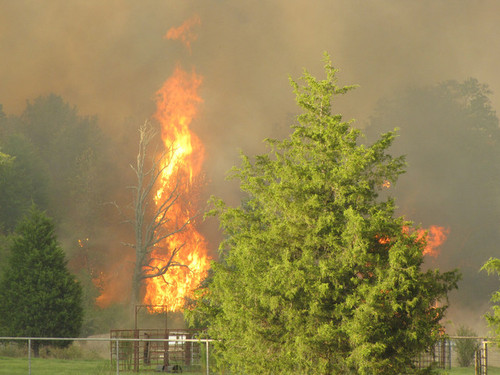Wildfires are a serious threat to lives, property and natural resources. Fire departments throughout the country make countless preparations for wild fires and train frequently to be ready for all types of emergencies, including wildfires. Horse owners need to do the same.

Horse owners: Prepare for wildfires
The greatest factor in limiting losses of horses during a wildfire is having and using a preparedness plan.
© 2012 by Lisa Combest
The greatest factor in limiting losses during a wildfire is having and using a preparedness plan.
An equine first aid kit is essential for all horse owners to have in the barn or trailer in case of emergencies.
Prioritize a list of tack to take during an evacuation.
Plan for several evacuation routes wherever possible. Prioritize the routes if you have the choice. Drive all the evacuation routes with your horse trailer. The exit routes must pass the questions of: Can I get out with my size of trailer? Is it passable in all weather conditions? and, What if there is flooding and a wildfire at the same time – how would the routes be affected? In some areas, wildfires are raging at the same time flooding is occurring.
Develop a team plan with a neighbor. This may help in the joint use of resources such as a trailer and supplies. It also helps to outline a joint plan. Inform each other in the case of an evacuation. Working as a team, you will be better able to efficiently evacuate in a shorter amount of time.
Have your horses permanently identified with microchips, brands, tattoos, or photographs then paint your cell phone number or the last four digits of your social security number on the horse. Place your identity halter on your horse (if you’ve prepared it ahead of time).
If you have only nylon halters, remove them because if your horses get too close to an actual fire, nylon halters get hot and could cause further skin damage.
Have your trailer in good condition and available to hitch up and load at any time. Keep a full tank of gas in the vehicle that you will use for towing the horse trailer. If you do not trailer your horse often or if you do not own a trailer, work with your horses to get them trained to load easily.
Make it a goal to be able to load horses with one handler so that in the case of an emergency they could be loaded quickly and easily. If you do not own a trailer, contact a neighbor who does and find out if he would be willing to help you evacuate your horse. It’s good practice to load your horse in the trailer you will be using to evacuate.
Wildfires: Response Actions
- Wet down roofs and other surfaces that might be damaged by fire. Be sure that your efforts do not jeopardize the water supply and pressure needed by firefighters.
- If officials evacuate your area, leave immediately.
- If you are evacuating horses when the fire is close, it may help to blindfold them. If there is time
- Remove blankets
- Place pieces of cloth around the horses’ nostrils to reduce the inhalation of smoke.
- Wet the horses’ tails and manes
- If you are unable to take livestock with you, let them out of the barn and close all the doors. A horse may run back into a burning barn if it gets frightened
- If you have time, try to lead your horses away from the buildings before releasing them to encourage them to move away from the buildings and the impending fire
- Turn off the power and gas
- Disconnect any electrical fences
Wildfires: Recovery Tips
- Monitor all animals exposed to fire for smoke inhalation pneumonia, the most common cause of fire-related death. Consult a veterinarian for any burn injuries
- Check any areas where animals and people will be for dangerous debris. Galvanized metal heated during a fire may be coated with toxic residues. If this occurs to your pasture fences, they need to be cleaned before any animals come in contact with them
- Don’t allow animals into areas where there may be ash pits (root systems that have burned underground)
- Take care when re-entering burned areas. There may be hot spots that could flare up without warning. Partially burned structures and trees can be very unstable, and may suddenly fall over.
- Do not tie animals to burned trees
- Consult with your insurance agent and have damages assessed as soon as possible. Take pictures or a video of damages
Remember to:
1. Plan.
2. Practice the plan.
3. Place people’s safety first – that includes your own
